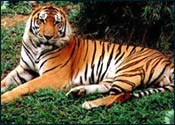|
|
|
|
|
|
|
|
|
Sunderbans Introduction
|
|
 Sunderbans is located at the southern tip of West Bengal , a stretch of impenetrable mangrove forest of great size and bio-diversity. A UNESCO World Heritage Site, the Sunderbans is a vast area covering 4264 square kms in India alone, with a larger portion in Bangladesh . 2585 sq. kms of the Indian Sunderbans forms the largest Tiger Reserve and National Park in India . The land that is inhabited by Royal Bengal Tigers is not far from Calcutta . You can explore unknown wildlife of Sunderbans that harbour jungle cats, fishing cats, Axis deer, wild boar, Rhesus monkeys, mongooses and the largest estuarine crocodiles in the world. Sunderbans is a part of the world's One of the most remarkable feature of this place is the bayonet like roots of mangrove forests that stick out above the water level. Nature apart, if you want to feel the essence of spirituality then this is the place to be. Sunderbans is located at the southern tip of West Bengal , a stretch of impenetrable mangrove forest of great size and bio-diversity. A UNESCO World Heritage Site, the Sunderbans is a vast area covering 4264 square kms in India alone, with a larger portion in Bangladesh . 2585 sq. kms of the Indian Sunderbans forms the largest Tiger Reserve and National Park in India . The land that is inhabited by Royal Bengal Tigers is not far from Calcutta . You can explore unknown wildlife of Sunderbans that harbour jungle cats, fishing cats, Axis deer, wild boar, Rhesus monkeys, mongooses and the largest estuarine crocodiles in the world. Sunderbans is a part of the world's One of the most remarkable feature of this place is the bayonet like roots of mangrove forests that stick out above the water level. Nature apart, if you want to feel the essence of spirituality then this is the place to be.
If you just want to enjoy the beauty of the Sunderbans without making an adventure out of it, be with us at StayResIndia.com, which helps you find suitable hotels near Sunderbans. We customize the tour package and offer the hotel accommodation. We maintain very good professional relationship with all the major hotel chains and independent properties in India including Sunderbans.
|
|
|
Top ˆ |
|
|
| Sunderbans Tourist Attractions |
|
|
| § Sunderban National Park |
|
Sunderban National Park lies southeast of Calcutta in the 24 Parganas district of West Bengal . Home to the Royal Bengal tiger; the national park is a part of the world's largest delta formed by the Ganga and Brahmaputra . Sunderban is also known for its unique mangrove forest ecosystem. The park is a tiger and biosphere reserve and has been designated as world heritage site by UNESCO. It extends about 260 km along the Bay of Bengal from the Hooghly River Estuary ( India ) to the Meghna River Estuary in Bangladesh .
|
|
|
| § Sajnekhali Bird Sanctuary |
|
The Sajnekhali Bird Sanctuary is situated on the confluence of Matla and Gumdi within the buffer zone that extends over an area of 885 sq km. Here you can have a look at the wide variety of birds, the most popular among them being the spotted billed pelican, cotton teal, herring gull, Caspian tern, grey heron, large egret, night heron, open-billed stork, white ibis, common kingfisher, brahmini kite and paradise flycatcher. A rare winter migrant, Asian dowitcher (Limnodromus semipalmatus), can also be found here.
|
|
|
| § Flora and Fauna |
|
The reserve comprises a core zone, afforestation zone and restoration zone and an agri-operation zone. The core zone of 1,300 sq. km represents the National Park and the rest of the area is used for the forestry operations. The variety of the forests that exist in Sunderban include mangrove scrub, littoral forest, saltwater mixed forest, brackish water mixed forest and swamp forest.
|
|
|
| § Bhagabatpur Crocodile Project |
|
The Bhagabatpur Crocodile Project besides being a hatchery and a sanctuary is the home to the biggest estuarine crocodiles. You can access this place through Namkhana.
|
|
|
|
|
Top ˆ |
|
|
|
|











